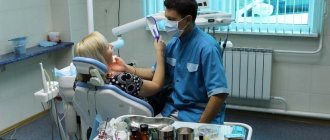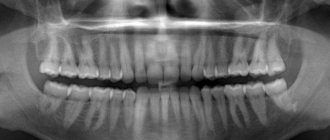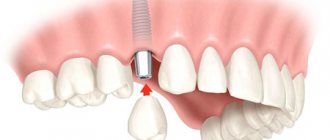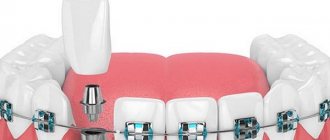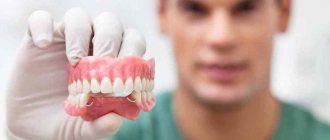A pediatric orthopedic dentist specializes in dental prosthetics for the youngest patients. Pediatric orthopedics is not the most common branch of dentistry, and therefore finding a real professional in this matter can also be difficult. A good doctor must not only thoroughly study the structure of the jaw apparatus in children, he must perfectly master prosthetics and dental restoration in children. In any clinical situation, the doctor must do everything possible to restore dental elements rather than give preference to installing a denture. The activities of a pediatric orthopedic dentist will be discussed in more detail below.
What does a doctor do?
In short, it is approximately the same as an adult prosthetist - he is engaged in the restoration and prosthetics of dental elements, but only in children. Despite the fact that these are the main tasks of a dentist, they still need to be distinguished.
The thing is that dental restoration and prosthetics in children are two radically different procedures. This applies not only to the indications for the procedure, but also to the process itself.
IMPORTANT! An experienced orthopedic dentist will never perform artificial prosthetics if there is at least a minimal chance of saving the tooth. This is especially important in pediatric orthopedics, since the child’s jaw apparatus is just beginning to form, and hasty prosthetics can result in a number of adverse consequences.
Restoration of dental elements
This procedure is carried out if the root of the dental unit remains intact. This technique is always resorted to when there is at least a small chance of saving the tooth and returning it to its original healthy appearance.
During reconstruction or restoration, an orthopedic dentist will create a crown based on individual measurements (in fact, it will imitate a regular tooth without being a prosthesis, because the root remains healthy). Next, the crown will be installed at the site of the damage.
Prosthetics
This procedure is resorted to if the tooth root has been damaged too much (or is completely missing). Naturally, with such a deviation, it will no longer be possible to restore the tooth, so the orthopedic dentist will create a modern and comfortable prosthesis that will replace the damaged or missing dental unit.
IMPORTANT! Prosthetics involves not only the complete restoration of the appearance of the damaged tooth, but also the preservation of all the basic functions of the element.
The prosthetic procedure involves the installation of various structures:
- Fixed elements (pins, crowns, inlays) . With this method, installed fixators and prostheses are not removed by either the patient or the doctor.
- Conditionally removable elements (prosthesis for one dental unit). Such structures can only be removed by an orthopedic dentist, but not by the patient.
- Removable structures (inserted dentures). Such elements can be completely removed by the patient; they are rarely used in pediatric orthopedics, almost never.
In addition, a pediatric orthopedic dentist deals with the elimination of disorders that were caused by dental injuries, as well as the treatment of the following problems:
- pulpitis;
- caries;
- cheilitis;
- periodontitis;
- dental erosion;
- persistent pain that occurs after filling a dental unit.
Until what age can dental implants be inserted?
The loss or removal of a significant number of teeth is typical for older people. According to statistics, almost 70% of pensioners need implantation. Dental restoration ensures proper chewing of food and a normal life. You can often see older people wearing removable dentures. But today more and more pensioners prefer implants. This is due to the high quality of such products, accessibility, and painless procedure.
Advanced age for dental implantation in itself is not a contraindication to the procedure. But the older a person is, the more chronic diseases he has, which pose a risk of implant rejection.
Surgical interventions are not recommended in the presence of the following diseases:
- diabetes;
- tuberculosis;
- malignant tumors;
- ischemia;
- infectious diseases during exacerbation.
Therefore, before performing the procedure, the doctor must study the patient’s medical history. It is also important to understand that the use of anesthesia increases the load on the heart. Therefore, anesthesia for older people is used with extreme caution.
In older years, immunity is weaker, and tissue regeneration processes occur rather slowly. Therefore, the older the patient, the longer the recovery period will be and the higher the risk of an unfavorable outcome of the operation. Therefore, the clinic’s doctors always carefully monitor the condition of elderly patients during the recovery period.
How can the doctor help?
Modern dental equipment allows not only to eliminate the violation of the integrity of dental elements in a small patient, but also to restore their original aesthetic appearance. However, all this can only be done by an experienced orthopedic dentist.
If you are looking for an experienced doctor who can restore your child’s beautiful smile, then contact our dental clinic. We employ real professionals who:
- will be able to give the child a new dazzling smile;
- in case of loss of a baby tooth, they will retain sufficient space for the formation of a molar (permanent) dental element;
- return the jaw apparatus to its full function so that the child does not experience discomfort when chewing food;
- will restore the tooth to its original condition, if the root was not damaged.
If a child needs dentures, the doctor will select the most comfortable and attractive option that your child will wear with pleasure. All prostheses and retainers are made of lightweight and hypoallergenic materials, so you don’t have to worry about the safety of your child.
Age as one of the contraindications to dental implantation
Installation of an artificial root in the jaw is a surgical operation in which soft and hard tissues are damaged and a foreign body is introduced into the bone, albeit from a biocompatible material. Such an intervention can be carried out only in the absence of contraindications. Therefore, the specialist always prescribes a dental and general examination of the patient before using this method of treating adentia. The installation of dental implants is contraindicated, in particular, in cases of cancer, acute infections, mental disorders, and immune disorders.
There are also age restrictions for dental implantation. These include ages up to 18-23 years, until the formation of the facial skeleton is completed. An artificial root, unlike a natural one, does not have shock-absorbing properties and after “engraftment” remains motionless. Therefore, if an implant is inserted into the bone tissue before its development and jaw growth has completed, it may do more harm than good.
In what cases is it worth going to a specialist?
You should contact a professional if you have the following deviations:
- The dental unit can no longer be restored. If neither fillings nor other treatments help, then you should at least consult an orthopedic dentist. This situation occurs especially often when the baby has severe caries.
- Fluorosis. If there is too much fluoride in a child's body, tooth damage cannot be avoided. So if you don’t want inflammation to occur, have the damaged area removed by an orthopedic dentist.
- The child has consequences of dental trauma. For example, a child knocks out or severely damages a tooth. In this case, the doctor will help restore the damaged tooth element.
- Too early loss of baby teeth. With this problem, the molars may not have enough space to erupt and secure. The doctor will help you choose a retainer for the child that will preserve space for the formation of the radical elements.
Causes of caries and pulpitis of permanent teeth in children and adolescents under 16 years of age.
There are 2 main causes of caries - the presence of caries-pathogenic bacteria in the oral cavity and an increased concentration of carbohydrate breakdown products, which create an environment for the proliferation of bacterial colonies. The acid released during their vital activity washes minerals out of the tooth enamel, it becomes porous, brittle and begins to break down - this is how caries forms. Read more about the mechanism of development of caries disease, types of caries and its symptoms in our article Treatment of caries in adults - they are completely identical in children.
Diet, of course, matters, but it is difficult to explain to teenagers that a passion for sugary soda and snacks undermines the health of their young permanent teeth. A grown-up child is trying to get rid of parental control and care, including dental hygiene, and his parents allow him to do this - after all, the child is already big. Unfortunately, our children at any age do not like to brush their teeth, and they do not know how to do it correctly. This approach leads to the fact that children aged 9-12 years are included in the main risk group and have the highest rates of caries and pulpitis.
The lack of habit of visiting a pediatric dentist at an earlier age leads to fear of the doctor; the teenager desperately resists going to the clinic - who wants to “give up”? At this age, the child does not want to show himself as “not cool.” As a result, 70% of children’s visits to the clinic are due to acute toothache, and this is almost a 90% chance of having pulpitis. Having received such a diagnosis at such an early age, there is a very high probability of not saving your tooth until adulthood.
Only thorough prevention can reliably protect a teenager from dental problems - regular professional hygiene and preventive procedures - such as remineralization and sealing of fissures of fragile teeth - they are effective and painless. We talk about this in more detail in the article on Children's prevention and hygiene.
Why is a child’s permanent tooth treated by a pediatric dentist?
The first permanent teeth appear in children aged 5.5 - 7 years. The latter are at the age of 11-15 years, we do not take into account wisdom teeth. A pediatric dentist has more experience and opportunities to work with patients of this age. The permanent tooth erupts immediately to its final size, will not change in the size of the visible part, but goes through other stages in development: mineralization and root formation. Mineralization of tooth structures is resistance to destruction. The first stages of strengthening - primary and secondary mineralization - occur during the formation of a tooth inside the jaw, then the tooth erupts and continues to become stronger and stronger, receiving minerals from saliva and a little from the blood. This occurs intensively in the first year after eruption and is called tertiary mineralization. In practice, the pediatric dentist, together with parents, influences the formation of tooth stability. Professional and home care is selected according to age and after determining the risk of caries. Even before dental treatment, you can reduce the risks of caries: we teach parents and children effective oral hygiene (through the plaque film, minerals from saliva do not enter the tooth enamel), we recommend and carry out fissure sealing permanent teeth. Fissures are depressions on the chewing surface of the teeth, narrow and deep, weakly mineralized at the time of eruption, food debris easily and permanently gets stuck in them and plaque forms, then caries appears. Sealing prevents fissure caries. The pediatric dentist isolates a healthy tooth from saliva, cleans the fissures from food debris and plaque, and fills the cavities with sealant. After the procedure, the tooth is easier to clean and the vulnerable spot is under reliable protection for years. The adult dentist does not have in his or her working arsenal the sealants needed in childhood and adolescence
An immature permanent tooth also requires careful treatment during the treatment of caries - enamel and dentin must be carefully assessed when removing the affected tissue. Treatment has to be carried out in two stages or using a sandwich technique: with conventional treatment, softened tissues are removed; in an immature tooth, these tissues are soft not because they are destroyed by caries, but because they did not have time to harden during the mineralization process. Then only the carious lesion is removed and the tooth cavity is closed with GIC material, which releases fluoride and enhances mineralization. After a few months, the condition is assessed and the GIC is completely removed and the cavity is restored with a composite (delayed treatment of caries), or covered with a composite on top (sandwich technique). Next, how to treat complications of caries (pulpitis and periodontitis) of a tooth with an unformed root?
When the tooth has just erupted, the length of the root is half of the future length and for another 4 years the root is “completed.” In a formed tooth, the root or roots are long with a pronounced narrowing at the apex, narrow root canals. In an unformed root, the walls of the root are thin, the lumen of the canal is wide, there are no narrowings at the apexes, the apex of the root closes at the very end of the “construction.” The root enlarges due to a tender growth zone, which some adult dentists take in the picture as signs of periodontitis. When treating complications of caries of an unformed tooth, it is important to preserve the growth zone - then the tooth will have a chance to continue development and perform its functions in the dentition, and not be sent for removal. You cannot choose devital methods in unformed teeth: use medications that “kill” the nerve of the tooth. The growth zone will die and root growth will stop. The root holds the tooth in the jaw; when the root of a baby tooth dissolves, the tooth dislocates because it no longer has support and falls out. A neurovascular bundle passes through the root of the tooth, in the canals; when the pulp (“nerve”) dies, the nutrition of the tooth stops and for an unformed tooth this is death. A formed tooth without pulp (“nerve”), with sealed canals, is hermetically sealed with a crown—and it serves for many years.
The next section of responsibility for a pediatric dentist is injuries to permanent teeth: from tooth and root fractures to complete knockout of a tooth from the jaw. The frequency of cases of treatment of injuries in the practice of pediatric and adult dentists does not coincide, a competent pediatric dentist clearly knows the protocols for treating injuries, and sometimes the help of an anesthesiologist is needed to treat complications of caries and the consequences of injury, because the child is in pain, and lip injuries are often combined with tooth injuries , cheeks, jaw fractures. The work can be complex, painstaking, require treatment under a microscope and is carried out while the child is sleeping.
The correct methods for treating an immature tooth: Indirect pulp capping – for deep carious cavities that threaten to progress from caries to pulpitis, without a history of pain Partial amputation of the coronal pulp with direct capping of the MTA – for fractures of the coronal part due to trauma with opening of the tooth cavity Amputation of the coronal pulp – in case of caries complications: pulp hyperemia, chronic pulpitis: part of the pulp is removed, the MTA of the canal mouths is blocked, and viable pulp is preserved in the canals, thanks to which root formation continues (Apexogenesis is the process of formation of the root apex if its growth zone is preserved.)
Apexification - the formation of an osteocement apical barrier, which is similar to a root apex with a large amount of fibrous tissue in the case when the germinal zone of the root has died - in this case it is almost impossible to do without a microscope; closer to the germinal zone, a barrier is created inside the canals
Treatment methods for teeth with immature roots are complex, requiring narrow specialization, equipment and materials, patient discipline and mandatory follow-up examinations and photographs to monitor the condition of the tooth.
If the prognosis for the tooth turns out to be unfavorable, then even in this case there are solutions: transplanting another tooth to the place of the lost one, for example, a wisdom tooth or moving the second permanent molar (“seven”) to the place of the lost first molar (“six”), but this is possible when roots of moved teeth in the formative stage
Prevention methods - home and professional hygiene, sealing and remineralization - are more pleasant, easier for the child, cheaper and more successful than treating complex cases



